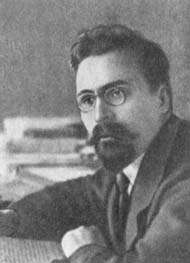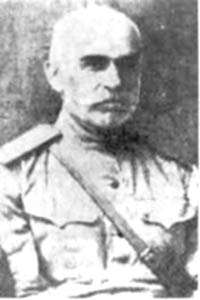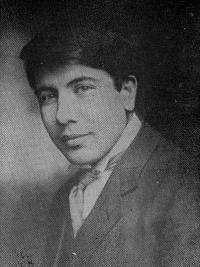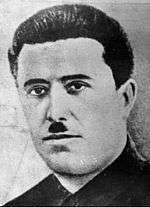Armenian victims of the Great Purge
A number of Armenian intellectuals, Bolshevik and later Communist statesmen, military and religious figures were killed during the Great Purge in 1930s by the Stalinist regime in an attempt to wipe out all political opposition in the Soviet Union.
Background
In the 1920s, the private property of the church was confiscated and priests were harassed. Soviet assaults against the Armenian Church accelerated under Stalin, beginning in 1929, but momentarily eased in the following years to improve the country's relations with the Armenian diaspora. In 1932, Khoren I became Catholicos of All Armenians and assumed the leadership of the church. However, in the late 1930s, the Soviets renewed their attacks against Church,[1] culminating with his murder in 1938 as part of the Great Purge, and the closing of the Catholicate of Echmiatsin on August 4, 1938. The Church however survived underground and in the diaspora.[2]
The Great Purge was a series of campaigns of political repression and persecution in the Soviet Union orchestrated against members of the Communist Party, the peasantry, writers and intellectuals, and other unaffiliated persons. In September 1937 Stalin dispatched Anastas Mikoyan, along with Georgy Malenkov and Lavrentiy Beria, with a list of 300 names to Yerevan to oversee the liquidation of the Communist Party of Armenia (CPA), which was largely made up of Old Bolsheviks. Armenian communist leaders such as Vagharshak Ter-Vahanyan and Aghasi Khanjian fell victim to the purge, the former being a defendant at the first of the Moscow Show Trials. Mikoyan tried, but failed, to save one from being executed during his trip to Armenia. That person was arrested during one of his speeches to the CPA by Beria. Over a thousand people were arrested and seven of nine members of the Armenian Politburo were sacked from office.[3]
As with various other ethnic minorities who lived in the Soviet Union under Stalin, tens of thousands of Armenians were executed and deported. In 1936, Beria and Stalin worked to deport Armenians to Siberia in an attempt to bring Armenia's population under 700,000 in order to justify an annexation into Georgia.[2] Under Beria's command, police terror was used to strengthen the party's political hold on the population and suppress all expressions of nationalism. Many writers, artists, scientists and political leaders were executed or forced into exile.
List
Below is the incomplete list of Great Purge victims from the Armenian SSR or other Soviet people of ethnic Armenian origin.
| Execution date & location | Person | Occupation | Rehabilitated? | |
|---|---|---|---|---|
| 9 July 1936[4] in Tiflis[4] |
Aghasi Khanjian |  |
First Secretary of the Communist Party of Armenia 1930-1936 | |
| 25 August 1936[5] in Moscow[5] |
Vagarshak Ter-Vaganyan |  |
Bolshevik revolutionary | |
| July 1937[6] | Axel Bakunts |  |
Writer | |
| 21 August 1937[7] | Sahak Ter-Gabrielyan |  |
Bolshevik revolutionary | |
| September 1937[8] | Sarkis Kasyan | |
Bolshevik revolutionary[9] | |
| 20 September 1937[10] | Lev Karakhan |  |
Bolshevik revolutionary | |
| 22 November 1937[11] | Movses Silikyan |  |
Military commander in the Russian and Armenian armies | |
| 27 November 1937[12] in Yerevan prison hospital |
Yeghishe Charents |  |
Poet, "the main Armenian poet of the 20th century"[13] | 11 March 1954[14] |
| 27 November 1937[15] | Ruben Rubenov | Politician, First Secretary of the Communist Party of Azerbaijan 1933 | ||
| 10 December 1937[16] | Christophor Araratov |  |
Military commander in the Russian and Armenian armies | |
| 11 December 1937[17] in Moscow |
Hayk Bzhishkyan |  |
Bolshevik revolutionary, military commander | 1956 |
| 1937 | Sargis Lukashin |  |
Politician, the Chairman of the Council of People's Commissars of Armenia from 1922 to 1925 | |
| 19 March 1938[18] | Ashkharbek Kalantar |  |
Archaeologist | |
| 6 April 1938[19] by NKVD[20] |
Khoren I |  |
Head of the Armenian Church | |
| 21 April 1938[21] | Suren Shadunts |  |
Politician, First Secretary of the Communist Party of Tajikistan 1934-1937 | |
| 18 July 1938[22][23] | Vahan Totovents |  |
Writer | |
| 1 August 1938[24] | Alexander Bekzadyan |  |
Soviet politician | 1956 |
| 1938[25] | Hovhannes Katchaznouni | |
Former Dashnak politician, Prime Minister of Armenia 1918-19 | |
| 26 February 1939[26][27] | Levon Mirzoyan |  |
Politician, First Secretary of the Communist Party of Azerbaijan 1926-29, First Secretary of Kazakh Communist Party 1937-38 | |
| 1943[28] | Zabel Yesayan |  |
Novelist | |
References
- ↑ Matossian. Impact of Soviet Policies, pp. 150, 194.
- 1 2 Bauer-Manndorff, Elisabeth (1981). Armenia: Past and Present. New York: Armenian Prelacy, p. 178.
- ↑ Tucker, Robert (1992). Stalin in Power: The Revolution from Above, 1928-1941. New York: W.W. Norton & Company. pp. 488–489. ISBN 0-393-30869-3.
- 1 2 Adalian 2010, p. 383.
- 1 2 "Советские правители Армении". Noev Kovcheg. February 2009. Retrieved 14 September 2013.
- ↑ Bardakjian, Kevork B. (2000). A Reference Guide to Modern Armenian Literature, 1500-1920: With an Introductory History. Detroit: Wayne State Univ. Press. p. 302. ISBN 9780814327470.
- ↑ "Армяне в "деле Лаврентия Берия"". Noev Kovcheg. October 2009. Retrieved 25 September 2013.
- ↑ Studies on the Soviet Union, Volumes 6-7, Institute for the Study of the USSR., 1966, p. 76
- ↑ Adalian 2010, p. 374.
- ↑ Rogovin, Vadim (2009). Stalin's Terror of 1937-1938: Political Genocide in the USSR. Oak Park, MI: Mehring Books. p. 112. ISBN 9781893638044.
- ↑ http://hpj.asj-oa.am/5798/
- ↑ Nichanian, Marc (2002). Writers of Disaster: Armenian Literature in the Twentieth Century, Volume 1. Princeton, NJ: Gomidas Institute. p. 2. ISBN 9781903656099.
- ↑ Coene, Frederik (2010). The Caucasus: an introduction. London: Routledge. p. 204. ISBN 9780415486606.
- ↑ Adalian, Rouben Paul (2010). Historical dictionary of Armenia. Lanham, MD: Scarecrow Press. p. 239. ISBN 9780810874503.
Charents was rehabilitated in a speech given by Anastas Mikoyan in Yerevan on 11 March 1954, in a presage of the political and cultural thaw that followed the death of Stalin a year earlier and anticipating the Khrushchev speech announcing de-Stalinization a year earlier.
- ↑ Реабилитация--как это было: Март 1953-февраль 1956 Андрей Артизов Междунар. фонд "Демократия", 2000 p. 181
- ↑ "Отечество и честь Христофора Араратова". Novoye Vremya. 14 January 2012. Retrieved 25 September 2013.
- ↑ http://lists.memo.ru/d7/f487.htm Memorial (society)
- ↑ Ter Minassian, Taline (2007). Erevan : la construction d'une capitale à l'époque soviétique (in French). Rennes: Presses universitaires de Rennes. p. 44. ISBN 2753503699.
- ↑ Payaslian, Simon (2007). The History of Armenia. New York: Palgrave Macmillan. p. 179. ISBN 9781403974679.
- ↑ Hewsen, Robert H. (2001). Armenia: A Historical Atlas. Chicago: University of Chicago Press. p. 259. ISBN 0-226-33228-4.
- ↑ "Шадунц Сурен Константинович". Sakharov Center. Retrieved 25 September 2013.
- ↑ "Vahan Totovents". writers.am. Retrieved 21 September 2013.
- ↑ "1938 թ. այս օրը վախճանվեց հայ արձակագիր, դրամատուրգ և բանաստեղծ Վահան Թոթովենցը". 1in.am (in Armenian). 18 July 2012. Retrieved 21 September 2013.
- ↑ "1937 К 75-летию великого террора". Kommersant. 19 November 2012. Retrieved 25 September 2013.
- ↑ Walker 1990, p. 424.
- ↑ "Мирзоян Левон Исаевич". Sakharov Center. Retrieved 25 September 2013.
- ↑ "Мирзоян Левон Исаевич". Great Soviet Encyclopedia. Retrieved 25 September 2013.
- ↑ Ruth Bedevian. "Zabel Yessayan Biography". Armenianhouse. Retrieved 10 October 2011.
- Bibliography
- Manoukian, A.S. "Հայաստանի հասարակական-քաղաքական գործիչները ստալինյան բռնությունների տարիներին [Armenian public-political figures in the years of Stalin repressions]". Lraber Hasarakakan Gitutyunneri (in Armenian) (1): 27–41.
- Walker, Christopher J. (1990). Armenia: The Survival of a Nation (revised second ed.). New York: St. Martin's Press. ISBN 978-0-312-04230-1.